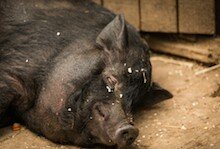How native can a (woman) poet be?
Esther Raab, a Hebrew poet born in Ottoman Palestine, is often touted as an exemplary native poet of the Land of Israel, an integral part of the national (male) canon. But, as Hamutal Tsamir shows, nativeness is a complicated thing – an ideal, a reality in some cases, but also a construct. More importantly, critics were blind to Raab’s particular subversion of exactly that identity, and completely ignored her gender-subversive feminine poetics and her female eroticism. Read here to see how Raab positioned herself as a woman poet in this scene.
Esther Raab’s second book was published in 1963 and awarded a loving, enthusiastic embrace from reviewers all along the critical spectrum. Almost all the critics described her as expressing – in a direct and precise way – the landscape of Eretz Israel [literally, the Land of Israel: in Jewish thought, the special term for the area believed to have been promised to the Jewish people by God in the Hebrew Bible. The Land of Israel is a concept; it is different from the state of Israel, which was established in 1948. – Trans.]
Raab’s direct approach supposedly emanates naturally from her biographical nativeness, from her authenticity as a native-born inhabitant of the Land of Israel [Raab was born in 1894 in the earliest Jewish agricultural settlement in Ottoman Palestine – Trans.]. Thus the words “authenticity”, “purity”, “rootedness,” “sensuality”, “concreteness” and “expressiveness” recurred in almost all the reviews as the main characteristics of Raab’s work, granting it apparent veracity and, therefore, undisputed value. One example is the review written by the poet Moshe Dor (under the pseudonym M. Ben Ya’akov): “How Eretz-Israeli this poetry is! . . . Only a poet who grew up in the heart of the old Eretz Israel, who was actually born there, can write like this, among the acacia borders, mesquite plants, love grass, dunes and the clay-red earth.”
[How is] Raab depicted as completely actualizing and filling the role of “the first native Eretz-Israeli [woman] poet”? [. . .] Since Raab is native-born, she [is said to know] how to describe the place as it really is. This model is based on an assumption of transparency: the world may be seen as it is through unmediated access to the truth via the objects one sees [. . .] Raab’s intense engagement with landscape and nature is no doubt the main player in this approach, and her expressionist-modernist poetics also have a central role: her unique language and free [verse] . . . liberated from metre and rhyme.
In fact, the dominant tendency to equate Raab’s poetry with the authentic Eretz-Israeli experience accompanied Raab all the long years of her creative life, even after the poetic rebellion of the Statehood Generation in the 1950s against their predecessors – even though this rebellious young generation of poets opposed what seemed to them over-nationalistic verse. As a native, and thus “Eretz-Israeli”, Raab would be expected to have been rejected by the Statehood Generation as well, together with the “nationalistic” poets of the 1940s.
And yet Raab was welcomed with great love and admiration. How and why was this possible? This young generation of critics embraced Raab because they interpreted her poetry in several ways that suited their own poetic ideology: some emphasize her nativeness as the opposite of conscious nationalism; for example, Moshe Dor wrote that in Raab’s poetry: “The landscape does not sing as it does for the immigrant writer who wishes to adapt to it knowingly, with awareness.”
Other critics read Raab as expressing a regional or Mediterranean or Middle Eastern – or even Canaanite – sensibility: as belonging to the entire region rather than simply to Eretz Israel. [The cultural-political Canaanite movement of Jews opposed a Zionist state allied with religion, and aimed for a close relationship of Jews and Arabs. – Trans.] The regional approach attempted to rid nativeness of nationalist significance by breaking out of geographic borders. For example, poet and translator Moshe Ben Shaul wrote that Raab’s poetry exhibited “a Canaanite sense”, contemporary and ancient, which is “Mediterranean: not local, patriotic, Israeli, [and] Jezreel Valley-ish, but regional”.
Other critics separated Raab’s work completely from historical, social and especially nationalist contexts, and defined it as purely romantic, universal and individual – about human beings facing eternal and infinite nature. Poet Natan Zach wrote, for example, that Raab’s poetry is “a characteristic 19th century romantic situation”, in which man is amazed by and longs for the infinity of nature, or, alternatively, finds in it “a refuge from human tumult”.
These approaches allowed critics to accept Raab enthusiastically in the 1960s, and harness her to their poetic project – undermining Jewish [identity] and building an Israeli identity. But, significantly, these approaches are precisely what prevented these critics from seeing Raab’s particular subversion of exactly that identity, and thus continued a long tradition of ignoring her gender-subversive feminine poetics, and her female eroticism and its definitive role in her poetry.
Indeed, it is only despite the fact that she is a woman – only by being perceived as a male poet of some sort – that Raab could be seen as a universalist, and, therefore, as a “true”, “pure” and “authentic” poet, and thus be accepted as “one of us”. In other words, the disregard for Raab’s feminine gender is exactly the condition for her acceptance into the canon of Hebrew poetry.
To take just one example, in Raab’s poem “White day rejoices over your nakedness”, the love for the land is not heterosexual – that of a man for the land-as-woman – but rather the love of a woman for a metaphorically feminine being; it is not articulated in terms of ownership and domination but rather, in terms of bathing together, and, most importantly, in a relationship of solidarity:
White day rejoices over your nakedness,
you, so meager and rich,
a mountain wall froze,
transparent as a fata morgana,
clinging to the horizon.
Noon. Expanses of your fields flare up
and your marrow goes completely wild and rises
against the white skies,
like an undending curtain
continuous and trembling.
Within the plain
a hill swells like a round breast,
at its crest surmounted by a white tomb;
in the desolation of stubble fields
a solitary thorn bush squats.
And if the eye
tires from flowing illusions-of-light
it will immerse itself in verdure
of the bluing thorn bush,
as into a pool of cool water.
You so poor with all your reddening furrows
in the gold distance
with the bedrock of your dry, white streams -
How fair art thou!
1923 (Translated by Harold Schimmel)
The poem depicts the Land of Israel on a blazing summer’s day. At its center is the well-known phenomenon of undulating heat waves which seem to make the air visible and concrete while at the same time blurring and blocking vision. The poem presents the land and the day making love together, without abandoning the structure of heterosexual erotic love. Rather, it enlarges this framework to cosmic dimensions of time (the day, which is masculine in Hebrew) and space (the land, which is feminine in Hebrew).
Various critics have suggested many ways to view the relationship between these two: the love of a man for a woman/the land; the [literal] love of day and land; a mother-daughter relationship; or homo-erotic relations between two women. Instead, I would like to say that, in effect, there is a triangle here: the eye (of the feminine speaker-watcher), the land (the addressee) and the day, and there are two separate but not unrelated systems of relationships – between the land and the day, and the land and the eye/speaker.
The most basic reversal [of the heterosexual paradigm] is the transformation of heterosexual relations between a man and the land into a cosmic event involving time and space. The land is not presented as a bride or a mother, whose sexuality is reserved for the man who conquers or buys them, who fights for them, but rather as a sexual female lover, despite her desolate sterility. This is not only a reversal of the conventional patriarchal-nationalist concept, but also takes possession of the ideas of sexuality and beauty, expropriates them from the male point of view, which admires and demands youthfulness, wealth and fertility, and liberates them from dependence on these values. Another reversal is of course the shift of focus . . . from the relationship of land and day to a focus on the relationship of the eye/the observer and the land.
The femininity of the eye/subject/woman speaker-poet is expressed in the act of bathing [immersion in Harold Schimmel’s translation – Trans.], as a signifier of an alternative sexual relation (or at least an alternative persepective). Whether this is homo-erotic, a mother-daughter relation or even a self-birthing, it allows for the the intimacy and solidarity of the speaker with the land. Its significance is enhanced by the traditional religious significance of bathing/immersion in water as a purification ceremony which [in Judaism] takes place before marriage and lovemaking (and for men, before transcribing a Torah scroll). It is impossible to determine exactly which of these possibilities is being depicted but there is no need, for this is Raab’s most important strategy in subverting the male-nationalist narrative. Through this means she saves the land and the speaker from fixed, hierarchical locations within the aggressive, heterosexual model of male subject/female object and all they imply. Moreover, Raab saves the woman poet from the stance of an object within the national literary discourse. She turns her into a creative eye which is not only not merely a passive observer, but active in the sense that action is power: she generates the landscape and significance of the objects she sees, and her own position in relation to them.
In any case, Raab’s nativeness was far more complex than it may seem: being a native was a major Zionist ideal – but for Raab, as a young woman who was born and grew up in the agricultural settlements of what is known as the first wave of immigration – it was reality. And yet her nativeness was also a construct.
First of all, [her identity] was comprised of many non-native elements: the language spoken in her parents’ home was Hungarian Yiddish, the cultural atmosphere was east-central European, the language of instruction in her school was French, and according to her biographer, her nephew Ehud Ben-Ezer, Raab’s father taught her German, and she eagerly read German and French literature as a teenager. The basic Hebrew spoken and taught at school was thin, which may perhaps explain Raab’s experimental and daring poetic language, and also testifies, of course, to the unnaturalness and non-native state of her Hebrew (which would have been like anyone else’s Hebrew at the time, since Hebrew was no one’s “native language” but, rather, an “acquired” native language . . . acquired-as-“native”).
Secondly, the idea of her nativeness lies deep within the ideology of immigrating and settling the land, the performative act that constructs the new Jew and the new society: this despite the fact that she was born into a family that had immigrated earlier in the first wave, and therefore was not in need of such performative actions. In light of the significant differences and tense relations between the first and second waves (the first was bourgeois, traditional, homebound and relatively conservative, and the second was pioneering and socialist), it says a lot that as a girl Raab was captivated by the rebellious youth of the second wave, and even learned to speak Yiddish with a [second wave] Lithuanian accent; it was so good that many people mistakenly thought she really was Lithuanian, she proudly said in an interview. She left her parents’ home to go to a kibbutz, and later participated in establishing a cooperative.
[Of course], the concept of nativeness and the land are central to modern nationalism. [In Benedict Anderson’s formulation, territory is conceived] as the concrete arena shared by the anonymous members of “imagined [national] communities” where they link, in the present, their ambiguous past to an eternal future. In the Israeli Zionist context, this issue is characterised by a particular complexity. The aspirations and longings of Zionist Jews to reach Eretz Israel from eastern and central Europe — immigrants who saw themselves returning to a homeland, as exiles and “ghosts” who aspired to nationhood and corporality – joined with a utopian-romantic national [identity] whose characteristics are “naturalness, freedom, honesty and innocence”. To these we may add [. . .] erotic and bodily liberation.
One might think that as a native, Raab could see herself as exempt from the ceremonial, performative and formative acts of the second wave; but the fact that she felt a need, nevertheless, to participate in them, shows that her nativeness – so apparently genuine and natural — was insufficient or not completely sufficient, even in her own eyes. Raab moved between two different positions in relation to the Zionist ideology of immigration and settlement. She embodies its realisation, she is the ideal native. But as such she deviates from the new immigrants for whom she represents an ideal and not reality (and who at this time enjoy a lot of cultural and social prestige, as well as a huge amount of organizational and political power). That is, just because she is the embodiment of a Zionist native ideal, Raab is ahead of her time. Her attempt to join the pioneers of the second wave is a necessary and understandable step towards “normalization”, which is, paradoxically, a step backwards.
Raab’s supposed nativeness and native poetics, and her standing and reputation as the “first Eretz-Israeli [woman] poet” – may be understood, then, not as a biographical-historical fact (whose meaning has been vague from the start) but mainly as a place where Raab positioned herself, and as an identity she fashioned for herself – a solution to her ambivalent situation . . . [as] on the one hand . . . [she represents] an ideal, but on the other hand . . . deviant, atypical, and almost abnormal (in a socialist Zionist society mostly comprised of immigrants). Through the construct of nativeness, Raab positioned herself as a (woman) poet – in the Hebrew Zionist canon.
Based on Chapter 3, ‘Gender and Territory Meet: The case of Esther Raab’, in Hamutal Tsamir’s In the Name of the Land: Nationalism, Subjectivity and Gender in the Poetry of the 1950s-1960s, Heksherim Institute at Ben Gurion University and Keter Publishing House, Be’er Sheva and Jerusalem, 2006 [in Hebrew]. Tsamir is a senior lecturer in Hebrew literature at Ben Gurion University of the Negev.








